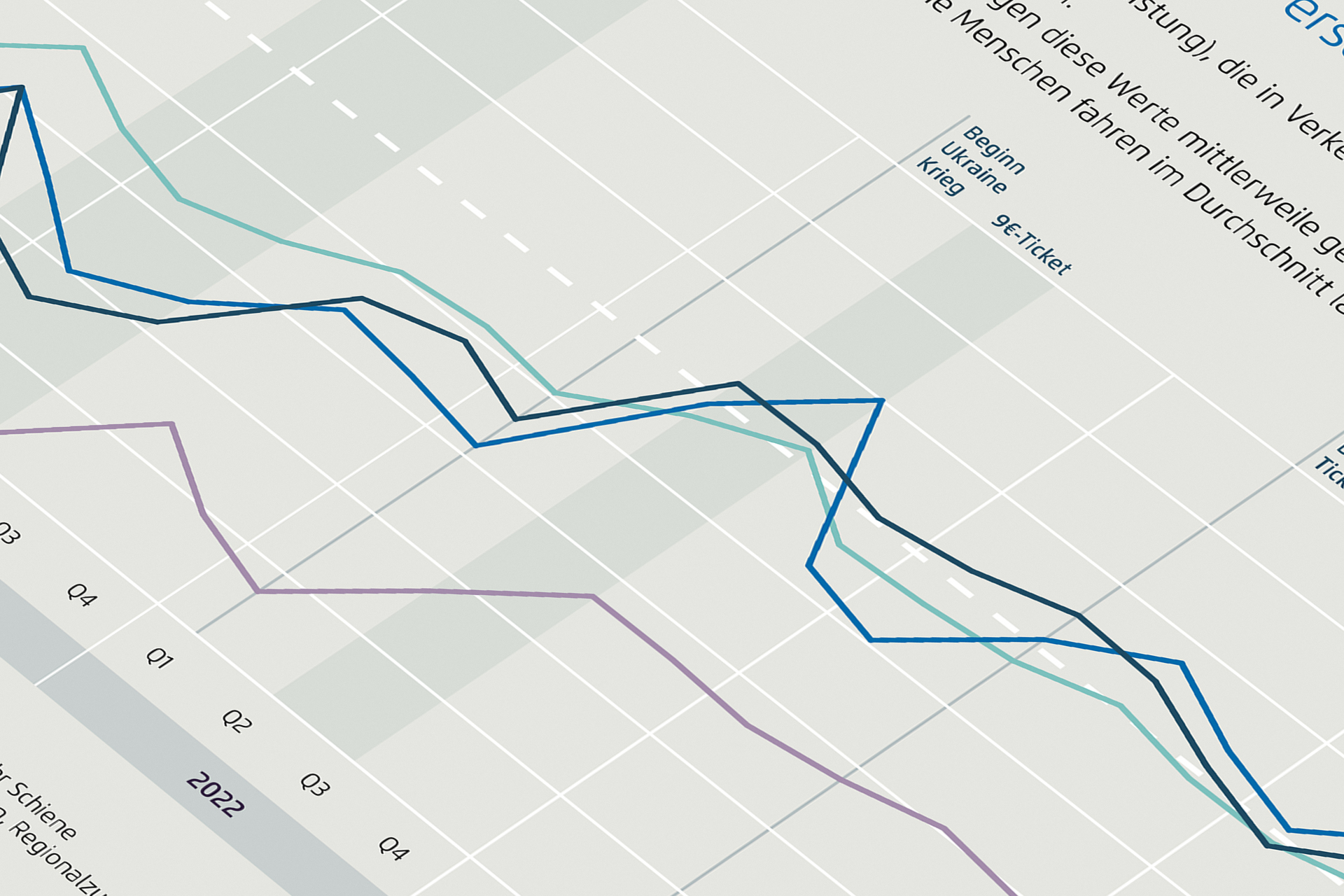Transport transformation radar: Car traffic still lower than before the COVID-19 pandemic
Data analysis by Agora Verkehrswende provides key figures on the changes on Germany's roads and railways / Working from home and the Germany-wide rail ticket are the main reasons for lower car use / Sustainable changes require political action

8 July 2025. Cars are still being used less in Germany than before the coronavirus pandemic, while the number of vehicles on the roads continues to rise. This is shown by the first edition of Verkehrswende-Radar, a data analysis report on transport transformation published quarterly by the think tank Agora Verkehrswende. Compared to the fourth quarter of 2019, the reference period before the coronavirus pandemic, car traffic on motorways in the fourth quarter of 2024 was 96 per cent, and on federal highways only 93 per cent. By contrast, the number of cars on the road grew to 104 per cent compared to pre-coronavirus levels. According to Agora Verkehrswende, the fact that cars are being left on the road more often is due, among other things, to working from home and the Germany-wide rail ticket. However, no close correlation with fuel prices can be observed.
Dr Wiebke Zimmer, deputy director of Agora Verkehrswende: ‘The era of traffic growth on German roads seems to be coming to an end. This was already apparent in our data analyses a year ago and is now evident again in our traffic transition radar. At the same time, the federal government is still a long way from aligning the framework conditions with emission-free mobility and logistics. A course towards climate neutrality in transport policy is not only essential for the well-being of society but also for maintaining Germany's competitiveness as a mobility location.’
Truck traffic has also been below pre-COVID-19 levels for several quarters (trucks on motorways in the fourth quarter of 2024: 96 per cent; on federal highways: 88 per cent). This is primarily due to the overall economic situation. Unlike passenger cars, however, the number of trucks weighing 3.5 tonnes or more has also declined slightly (98 per cent).
Information for politics, business, and society
In addition to car and truck traffic volumes, the Verkehrswende-Radar provides key figures and infographics on other aspects: demand for public transport, developments in vehicle fleets and charging infrastructure, and the availability of battery-electric cars.
The analysis is mainly based on publicly available data, for example, from the Federal Highway and Transport Research Institute (BASt), the Federal Statistical Office of Germany, the Kraftfahrt-Bundesamt (the higher federal authority for road traffic) and the ADAC (a German automobile association). Agora Verkehrswende works with the consulting firm KCW to process the BASt data. An advisory board of experts advises Agora Verkehrswende on the development and further implementation of the data project.
Dr Philine Gaffron, project manager at Agora Verkehrswende: ‘Anyone who wants to make transport in Germany that is fit for the future should keep an eye on the relevant key figures. With our Verkehrswende-Radar, we want to make this easier for all interested parties – whether in politics, business, or society.’
Longer distances in public transport
The Verkehrswende-Radar shows a slightly positive trend for public transport. Passenger numbers in local public transport temporarily exceeded pre-coronavirus levels in 2024, while transport performance in passenger kilometres remained consistently above pre-coronavirus levels (local rail transport in the fourth quarter of 2024: 110 per cent; local road transport: 103 per cent). This means that people now travel slightly longer distances by bus and train than they did before the pandemic. However, Agora Verkehrswende believes that the necessary increase in public transport in the future will only be possible with a massive and long-term expansion of services.
Purchase incentives for electric cars make sense, especially in small vehicle segments
In order to assess the availability of battery electric vehicles (BEVs), the Verkehrswende-Radar evaluates the list prices of vehicles based on market data from the ADAC. For the first quarter of 2025, the radar shows that numerous BEV models will be available in all vehicle segments. Although there are significantly more in the upper segments (upper mid-range: 467 models, luxury class: 323), the choice is also growing in the lower segments (microcars: 23 models, small cars: 76).
The average prices for battery electric vehicles in the first quarter of 2025 ranged from just under 33,000 euros for a microcar to around 87,000 euros for a luxury car. In the upper segments, the average prices of BEVs were not far from the prices of comparable combustion engine vehicles. In the mid-range segment, the price difference was only 8 per cent, compared to 38 per cent for microcars. Agora Verkehrswende therefore believes that political measures to promote electric mobility should also aim to make BEV models in the small segments more affordable by offering income-based purchase incentives for households on a tight budget.
The Verkehrswende-Radar is an information service provided by Agora Verkehrswende and can be accessed online in German at: https://www.agora-verkehrswende.de/veroeffentlichungen/verkehrswende-radar.
About Agora Verkehrswende
Agora Verkehrswende is a Berlin-based think tank that seeks to promote climate-friendly mobility. Non-partisan and non-profit, it works together with key stakeholders in the fields of politics, business, academia and civil society to decarbonise the transport system. To this end, the think-tank team develops evidence-based policy strategies and recommendations. Agora Verkehrswende was initiated in 2016 by Stiftung Mercator and the European Climate Foundation. More information: www.agora-verkehrswende.de

